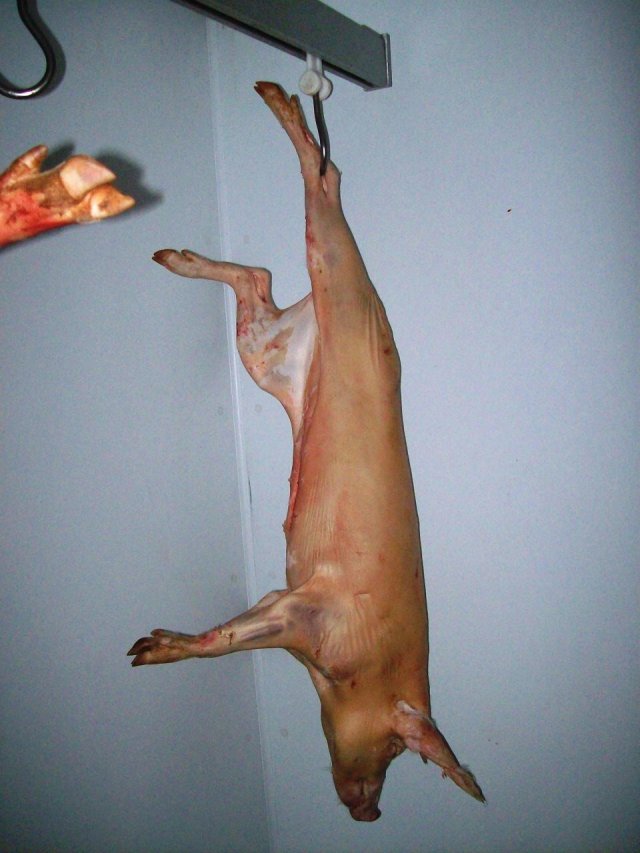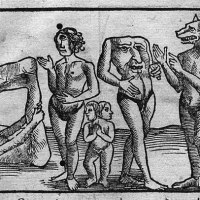
Princeton Environmental Institute

Pigs. Unknown attribution
[First posted July 2009, Revised 09 December 2011]
Pigs have had a contentious history. To begin with, they usually reside near the bottom of the livestock prestige pyramid, with cattle, horse and camel occupying the higher niches, sheep, goats and poultry found in various middle ranges, and pigs almost always at the bottom. As well, their habit of eating just about anything, including offal, are considered abhorrent in some cultures – and helps to condemn them to ‘no-no’ lists of foods by several religions.

Horus (L) and Seth (R) assisting pharaoh. Seth was considered a pig during certain periods of Egyptian history, and in different locations of the Nile valley.

However, recent excavations in Egypt have demonstrated that pigs were farmed and eaten, although they were apparently consumed mainly by the lower strata – at least in the Old Kingdom:

Pig consumption at an Old Kingdom site (c. 3000 BC) vs. other livestock
The above chart is found in this detailed study, which looks also at consumption of different cereals at the same Old Kingdom site, located in the Delta (Northern Egypt).
But throughout 3500 years of history, it still is not clear if pig-raising and consumption were continually practiced. What is clear, is that the evaluation of pigs – and of Seth as a pig – changed over the millenia in Egypt. More detailed information on pigs in pharaonic Egypt is found in Choice cuts: meat production in ancient Egypt Par Salima Ikram.

A Pig being transported in a boat, urged on by a monkey

Pig, Hierankonpolis Predynastic (3500-3000). Ashmolean, Oxford
As for their utility in agriculture, Herodotus (who travelled to Egypt about 450 BC) mentions that:
…when the river(Nile) has come up of itself and watered their fields and after watering has left them again, then each man sows his own field and turns into it swine, and when he has trodden the seed into the ground by means of the swine, after that he waits for the harvest, and when he has threshed the corn (wheat) by means of the swine, then he gathers it in.
From: Herodotus, An Account of Egypt (Kindle edn.)
Another benefit of using pigs in this manner relates to manure and urine that pigs deposit in the fields as they are rooting about. It is a symbiotic relationship between herds and cultivation similar to that found in Northern Nigeria amongst Hausa farmers and Fulani pastoralists – who are cattle and small stock herders. The latter bring their cattle into the Acacia Senegal groves of the Hausa farmers to eat the acacia pods, which are highly nutritious, and in return the cattle deposit manure and work the soil.
Perhaps, in a similar way, pig-herding in the Nile valley was conducted by specialized groups, which could have been either ‘ethnic’, religious or strata-based. But I am unaware of any evidence in this regard, other than information given by Herodotus, quoted below. Further, I think that the practice described by Herodotus refers to farming in the Delta (Lower Egypt) only, and may not have been the case further south, in Upper Egypt, so we don’t know if and how pigs were farmed and used in other parts on the valley.
Herodotus suggests that pig-herders, at least in the Delta, are a separate group:
The pig is accounted by the Egyptians an abominable animal; and first, if any of them in passing by touch a pig, he goes into the river and dips himself forthwith in the water together with his garments; and then too swineherds, though they may be native Egyptians, unlike all others, do not enter any of the temples in Egypt, nor is anyone willing to give his daughter in marriage to one of them or to take a wife from among them; but the swineherds both give in marriage to one another and take from one another.
Now to the other gods the Egyptians do not think it right to sacrifice swine; but to the moon and to Dionysus alone at the same time and on the same full-moon they sacrifice swine, and then eat their flesh…”

A rare figure of a pig. Herodotus says that, " the poor ...by reason of the scantiness of their means, shape pigs of dough and having baked them they offer these as a sacrifice..."
But pigs were certainly not taboo when it came to medicine. The Papyrus Ebers, a medical papyrus lists several remedies using the parts of a pig, including the injection of the humor of a pig’s eye into the ear of a person to cure blindness (ears and eyes were thought to be connected , which of course they are – a fact no doubt gained from procedures associated with removal of the brain as part of mummification in ancient Egypt).

A portion of the Papyrus Ebers, which contains medical treatment for numerous diseases

Ebers Papyrus, section on use of pig eye humor for treatment of eye problems
Prescriptions from Papyrus Ebers:
Another (remedy) for not allowing hair to grow in the eye after it has been pulled out… To be applied to the place of this hair after it has been pulled out. It will not grow (again)…
The second remedy is similar to the first but includes blood of ox, ass, pig, hound, and goat.
– Papyrus Ebers 425

'Riri' - one of the words for 'pig', in hieroglyphics
Medieval Europe: Recently I was searching for information on medieval agricultural techniques and was interested to see that, in various manuscripts depicting the Labors of the Months, November is always shown with some form of pig husbandry. In two of the three examples below, the pig is being slaughtered. Presumably this would be slaughter following heavy eating by pig herds during the fall in the forests, and then butcher and preservation of the fattened pigs. That’s just a conjecture:

Labours of the Months - November. Preparing to slaughter a pig. Arras, France 1243

Labours of the Months - November - Youth in the act of braining a pig. France c.14th.C.

Labours of the Months. November - Pig herders. France, n.d.
Early America: An interesting outline of the history of pork in America is given here, where it is noted that Wall Street in New York was so named because it originated as a wall to keep pig from migrating into town. Smoking was widespread at the household level until the early 20th. Century. My family had a brick smoke house in the back of the estate, located near the cookhouse and the spring. That was down South, and was a practice that stopped in the early 20th. Century.

Smithfield ham.
The Middle East: Pigs are considered unclean both by Muslims and Jews, but not for Christians, who in Cairo have traditionally raised pigs in closed quarters in association with garbage collection. These garbage collectors, called zibbaliin, have for centuries fed pigs out of the refuse collected in the city. It has been a profitable business, until 2009, when the Egyptian Government decided to slaughter all pigs in order to avoid Swine Flu. There continues to be extensive controversy about this move.

Egyptian Copts (orthodox Christians) with their pigs during the pig cull. Source - Reuters
Contemporary: Two outstanding anthropologists have written about the role of pigs in culture and society, Roy Rapport ( Pigs for the Ancestors: Ritual in the Ecology of a New Guinea People) and Marvin Harris (The Sacred Cow and the Abominable Pig: Riddles of Food and Culture) and are well worth reading.

Rappaport - Pigs for the Ancestors
In Burundi pigs are not commonly raised, though there is no prohibition against eating them. Various humanitarian organizations have promoted pig production over the last decade to assist poorer families, primarily because they are so prolific:

Sow & piglets in a South African agricultural research station
However, I am against this policy for several reasons – most importantly, because pigs compete with humans in their food consumption and Burundi is already a severely food deficit country. Furthermore, they can be extremely harmful to farm lands where there is insufficient land and food.

A freshly slaughtered pig from the village, for this weekend's BBQ at the Hotel Club du Lac Tanganyika
Related articles
- Was Narmer The First Pharaoh of Egypt? (socyberty.com)
- What food was in Ancient Egypt (wiki.answers.com)
- The First Dynasty of Egypt (socyberty.com)
- Libya – Prehistoric Links with the Nile Valley (dianabuja.wordpress.com)


























Pingback: Christmas in Africa: Village-Style in Burundi « Dianabuja's Blog
Great post – and thanks for stopping by my blog too. If you have any suggestions for my year of reading the world next year (http://ayearofreadingtheworld.com/) I’d really appreciate them as I still have quite a few gaps on the list, particularly for African countries. Keep up the good work!
LikeLike
Thanks, and I’ll get back to you during the weekend on possible reads.
LikeLike
Pingback: Most Popular Blog Pages – Why?! « Dianabuja's Blog
Very nice article I like your site carry on the amazing posts
LikeLike
Thank you Thomas!!
LikeLike
I appreciate the breadth of this post. Great job.
LikeLike
Thanks, Scott. It’s not that I have a particular interest in pigs, boar or pork – it’s just that they keep coming up in so many places.
LikeLike
Pingback: Suckling Pigs and Divine Nobles in Ancient Egypt « Dianabuja's Blog
Lovely post, Diana, just lovely, and very informative. Great pictures.
LikeLike
Thanks, Cynthia! 🙂
LikeLike